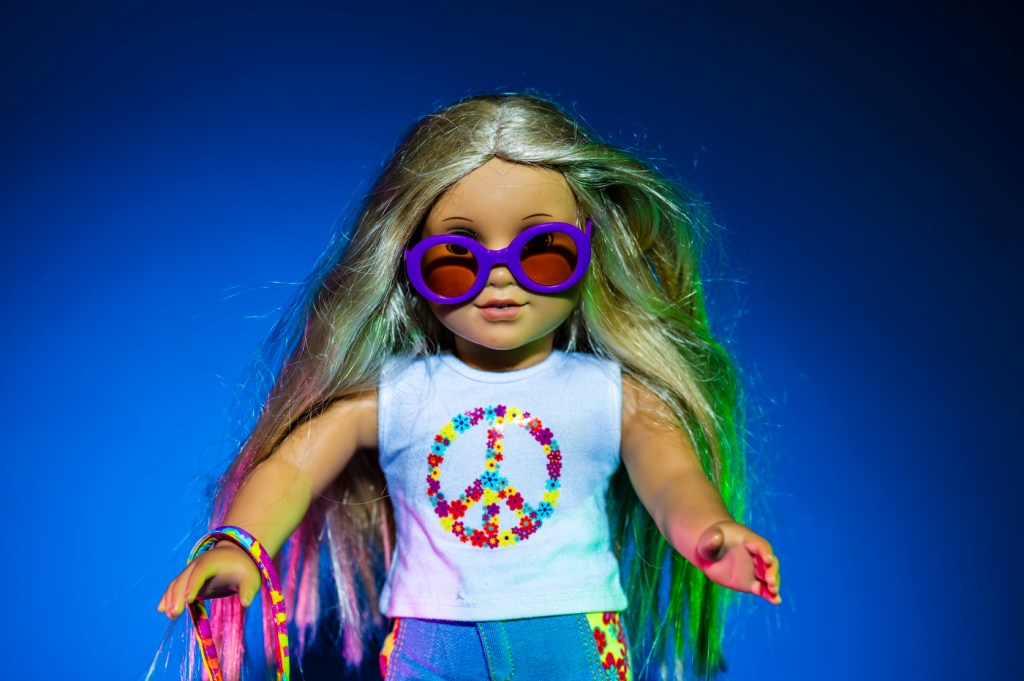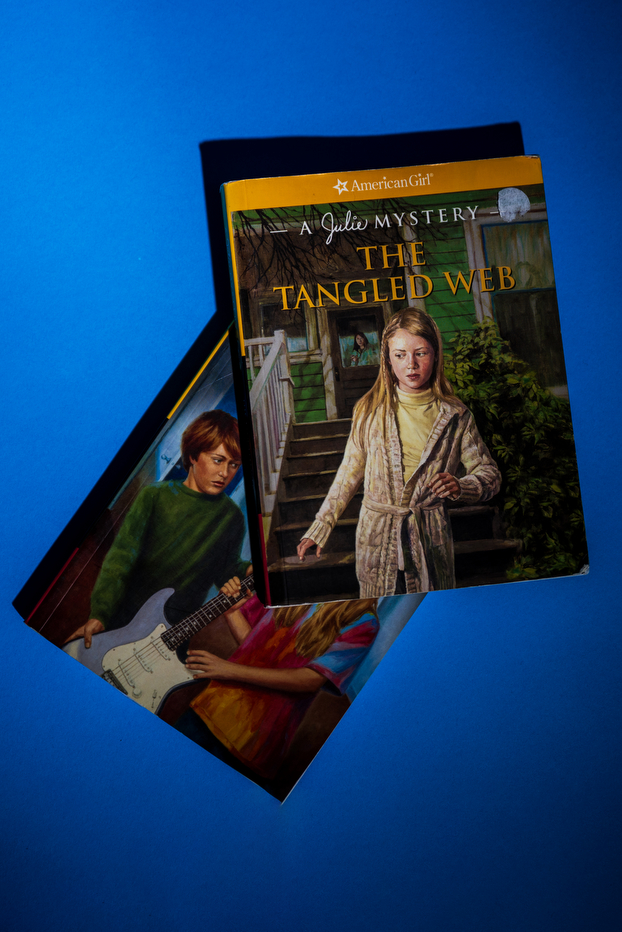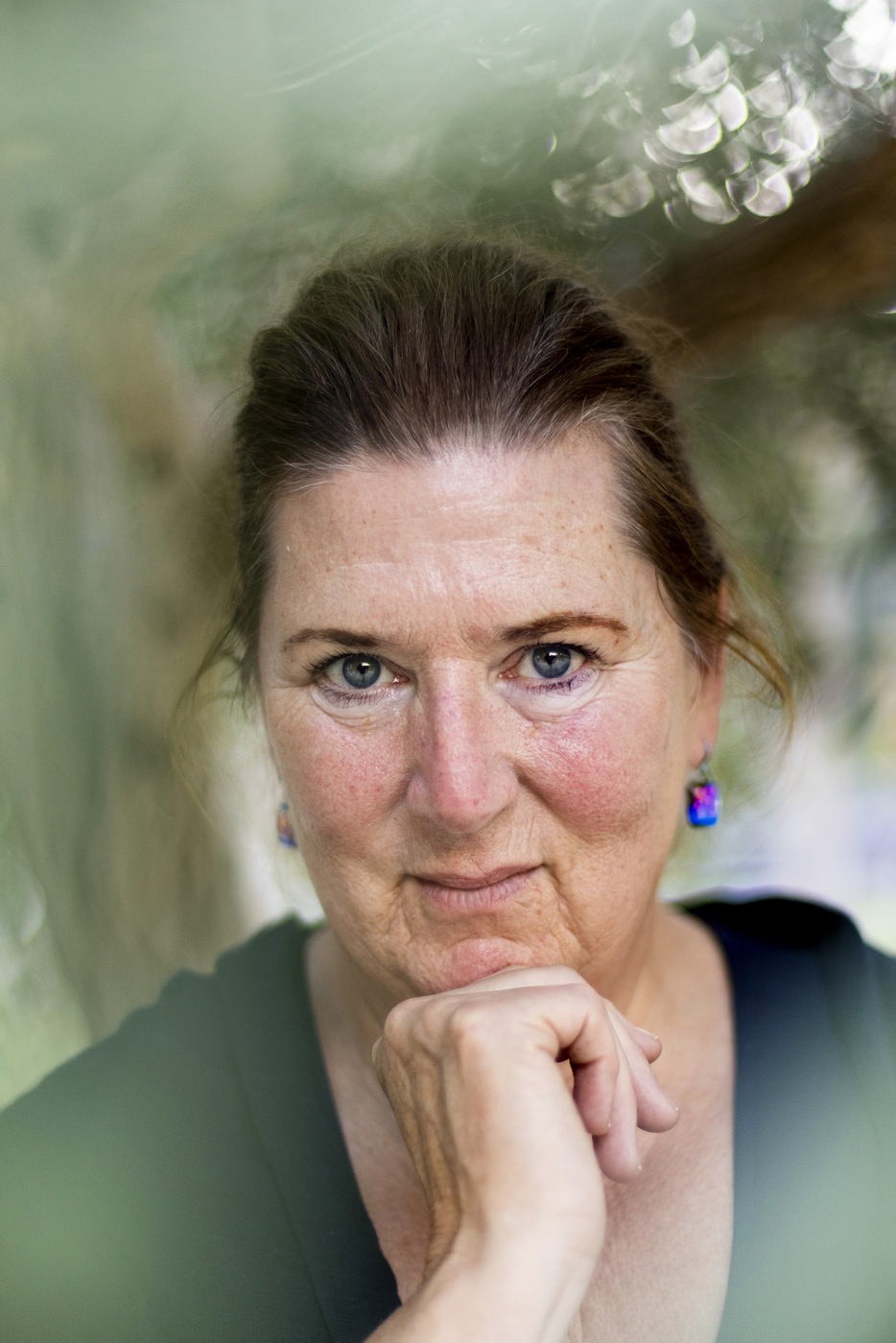Published on
Why American Girl has been a perfect fit for this creative writing professor
Northeastern’s Kathryn Reiss has authored several mysteries for the iconic book and toy company alongside her award-winning, original middle grade fiction.

In “The Silver Guitar: A Julie Mystery,” by Kathryn Reiss, Julie Albright, a 10-year-old girl living in 1970s San Francisco, gets involved in a glitzy auction to raise money for an oil spill disaster cleanup off the California coast. The most prized item on offer — a silver guitar that once belonged to a Jimi Hendrix doppelgänger — becomes central to a slowly-unfolding whodunnit involving San Francisco’s hippie elite, a class project, and a conspiracy to steal scores of precious artifacts and replace them with fakes, including a Van Gogh sketch and Abraham Lincoln’s top hat.
By the end, Julie and her friends solve the mystery, learning a valuable, overarching lesson about the danger of snap judgments along the way:
“Why would you suspect me?” a character asks Julie in a passage near the book’s resolution. “Because we jumped to conclusions, Julie thought. She had suspected nearly everyone based on what she thought was evidence. Just as the oil spill wasn’t really the ship captain’s fault. Mom had helped her see that the blame for the oil spill in the bay was not clear cut. Now Julie realized that the theft of the silver guitar was also more complex.”
Published in 2011, “The Silver Guitar,” is an entry in the American Girl imprint’s “Mysteries” series. Julie, as AG devotees know, is a doll with long, center-parted blond hair and a peace sign T-shirt from the iconic toy brand, which sells dozens of doll characters with fully fleshed out canons often set against the backdrop of key periods in U.S. history. There are clothes, furniture and accessories to go with them — not to mention dozens of books and short stories.
Reiss, a creative writing professor on Northeastern University’s campus in Oakland, California, has authored several mystery novels for American Girl alongside her award-winning, wholly original middle grade fiction. In addition to three other Julie mysteries, she has written for the 1900s-era Rebecca and Depression-era Kit characters.
“Kathryn’s American Girl books are among the ones I’ve enjoyed reading [the most],” says Kristin McGlothlin, a fan and fellow middle-grade author who especially loves Reiss’ “A Kit Mystery: Intruders at Rivermead Manor.”
“The historical context is written into the story seamlessly,” she says. “I’ve found reading some of the American Girl series that the era’s trends can stick out to the reader.”


Julie was an ideal muse for Reiss, and not just because they both call the Bay Area home. American Girl books writ large bring together elements the author is drawn to in all her work: the historical past, memory, enterprising female protagonists, mystery with a light element of peril, trenchant life lessons. Her work for the company, which has stretched from the early 2000s to her most recent “Julie” book in 2018, has been a welcome complement to the rest of her career.
That includes her role as an educator: Many of Reiss’ creative writing students have become successful novelists in their own rights, including Nina LaCour, Aiden Thomas and Carly Anne West.
Editor’s Picks

‘Poison’ or fuel? Northeastern dietician explains sugar’s effects on the body

Northeastern research finds companies with LGBTQ+ board members outperform peers

Northeastern students develop AI tool to prevent electronic health record outages from delaying care

New book from Northeastern professor looks at history of groundbreaking criminology study

Gregory Abowd, dean of College of Engineering, elected to the American Academy of Arts and Sciences
“I think about her a lot in terms of having this really outsized influence on multiple generations of middle grade writers,” says Stephanie Young, a poet and literary scholar who has been on the faculty with Reiss since 2005.
LaCour, a 2006 MFA graduate, wrote her debut novel with Reiss an adviser. “I respect Kathryn’s career so much,” she says. “She was my first example of a real working writer —someone with such talent and skill and tenacity.”
She describes her professor as an enthusiastic scholar of the Young Adult genre, always discovering new works. “She stayed very current with her book selections. She had some core novels that she taught over and over but would always weave in newer releases, too. She taught YA as an ever-evolving category of literature, which was so beneficial.”
‘Creepy ghostie’ novels
Reiss realized she had a knack for stories centering kids and teens in the middle of her first manuscript. After finishing up her undergraduate degree at Duke in 1980, she was on a Fulbright fellowship in Germany when she began sketching out an idea for a novel. “I thought, well, it’s going to be a mystery, it’s going to be about time, there’s going to be a big old house, there’s going to be the possibility of a ghost,” she remembers.
Originally she told the story — about a girl who becomes entranced by a dollhouse in her attic — from the perspective of the girl’s concerned parents.
“I was writing it from the mother’s point of view, that she’s watching her daughter grow obsessed with this dollhouse,” Reiss says. “I had handwritten 40 pages of that before I realized: No, the really good story is not the mother worrying about her daughter’s sanity, but the daughter who has really stumbled upon magic. When she looks into the dollhouse, she can see into the past of what happened in their own house.”
I respect Kathryn’s career so much. She was my first example of a real working writer —someone with such talent and skill and tenacity.
Nina LaCour, a bestselling YA novelist and Kathryn Reiss’ former student
The eventual novel, “Time Windows,” came out in 1991 and was a commercial and critical hit. Still in print, Reiss’ debut was an American Library Association Best Book for young adults; Kirkus Reviews called it “well-wrought and entertaining.”
“Dollhouses plus time travel? I was sold,” remembers Jessie Schiewe, a fan who discovered “Time Windows” in a California thrift store in the early 2000s and became a devoted reader. “I don’t read thrillers or suspense novels normally. I have never enjoyed a murder mystery. But Reiss’ suspense is a different kind of suspense. It’s rooted a bit more in fantasy and touches on many of the spooky things I dwelt on as a kid.”
A sequel, “Pale Phoenix,” shortly followed “Time Windows,” and Reiss has published 18 more novels marketed under the “middle grade” or “young adult” designations since. Often, her work takes the form of suspense thrillers involving history or time travel; she affectionately calls them “creepy ghostie” novels. “I’m sort of writing for myself as a kid,” Reiss says. “The books I would want to be reading.”
A few years before “Time Windows,” in 1986, Pleasant Company (the brand that would become American Girl) had launched its initial line of dolls and books depicting pre-teen girls living in U.S. historical periods from the Colonial era to World War II.
A mother of seven, Reiss first came across the first American Girl books when her children were little. “I remember reading them [with my kids] and thinking, ‘I would have loved these books,’” she says.
Reiss teaches on the history of middle grade and young adult novels dating back to the 19th century, and she points out that American Girl came along just as the market for kids’ historical fiction was booming. “There were some books in earlier decades, but there weren’t whole series of them until the ’80s. American Girl was one of the first. They really had a huge impact and got people thinking about how to present history for children and be accurate, but also not overwhelming.”
Playing with dolls
By the ’90s, American Girl had become a household name and grown to include a full-blown publishing imprint with several spinoff novel series. Reiss’s first book for American Girl was “Riddle of the Prairie Bride” (2001) an entry in the now-discontinued “History Mysteries” series of original stories elucidating true historical scenarios. The plot focused on a young girl whose father married a mail-order bride on the Kansas prairie in the 1870s, a common practice at the time. Reiss followed it up in 2003 with a mystery set during the 1906 San Francisco earthquake, then didn’t hear from American Girl for nearly a decade.
The Julie doll came out in 2007. After she got over her initial confusion about the ’70s being considered history — “I thought ‘Oh no, I guess I’m getting historic too,’ she laughs — Reiss took on an assignment to write books for a new mystery series linked to the company’s ever-growing roster of historic doll characters. She eventually wrote four for Julie and six in all between 2009 and 2017.
Writing for beloved, existing characters, all with several books of what the industry terms “core fiction” constituting their backstories, was a different type of creative challenge for Reiss. “I imagine it’s a bit like writing episodes of a TV series,” she explains. “You can’t have anything upset the established timeline.”
For instance, Julie’s parents are divorced. “I can’t get them back together again,” Reiss says. “All of the mysteries are completely my own invention, and I can bring in new characters, but they can’t change the basic life [Julie and the other core characters] are living.”
I imagine it’s a bit like writing episodes of a TV series. You can’t have anything upset the established timeline.
Northeastern University Oakland professor Kathryn Reiss on writing books for American Girl
A fun perk of writing for American Girl: a doll was included with every book contract. Between those and the dolls her four daughters had growing up, Reiss has amassed quite a collection. “I even have Julie’s best friend, Ivy,” she says. “Now we have grandchildren, and my husband and I were just saying, ‘Oh, maybe we should get them out of the closet.’”
Writing, living history
American Girl has been a fun detour for Reiss, but it also dovetails nicely with themes that preoccupy her in her primary writing and teaching career. She thinks a lot about the ways literature can help us make sense of a shared, historic past.
“The morning after 9/11, in 2001, I was teaching a creative writing class, and the towers were still burning in New York,” she remembers. “I was saying to my students, ‘the horror of what’s going on right now … eventually there will be books written about this, even though we can’t imagine how this is going to translate into fiction.’”
Especially in children’s literature of previous decades, there was a long processing time between historical events happening and them being distilled into fictional narratives; young adult books about the Holocaust, for example, didn’t really rise to the fore for about 40 years. Lately, though, Reiss has noticed fiction grappling with an increasingly recent past.
“After the 2016 election, there were new books coming out by YA authors about refugees and immigrants fleeing desperate situations that were much more contemporary,” she says. “Now I think there’s more of a push to write about events that are still pretty current, rather than waiting a decade or so to process it.”
That recency creep is present in American Girl products as well. When Pleasant Company’s first three dolls came out in 1986, the most “recent” character, Molly, lived in the 1940s. Last year, the company introduced a “historical” pair of twins, Nicki and Isabel, anxiously anticipating Y2K. Reiss herself is finishing up revisions on a young adult manuscript set during the lockdown days of the COVID-19 pandemic; the plot involves the U.S. foster care system, an old house, and, true to form, a time portal. “I’ve had a great time writing it,” she says.
“Her writing has never been static,” says Young, Reiss’ Northeastern colleague. “She’s an example of what a writer can be over a long career, and that’s so amazing for younger writers to see. You can have this kind of reach. You can have this kind of variety.”
Schuyler Velasco is a Northeastern Global News senior writer. Email her at s.velasco@northeastern.edu. Follow her on X/Twitter @Schuyler_V.






